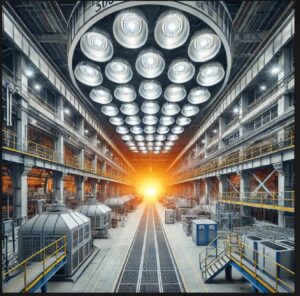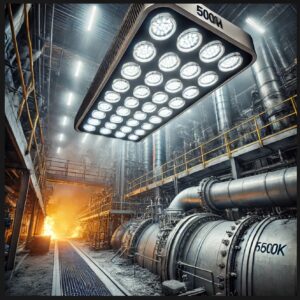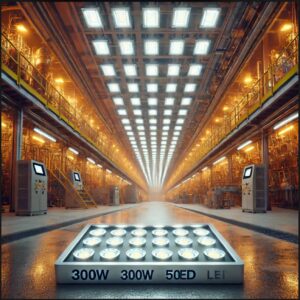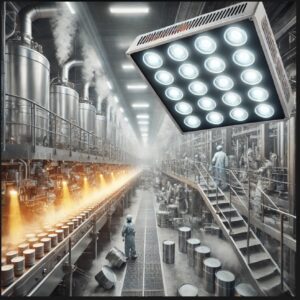- Electrical Failures: Degraded wiring and ballast components can cause short circuits, leading to potential fire hazards and costly equipment damage.
The risks associated with frequent failures, short lifespans, and high maintenance costs make traditional lighting unsuitable for extreme heat environments. High-temperature-resistant LED lighting provides a superior alternative by offering longer operational life, reduced maintenance needs, and enhanced safety in demanding industrial conditions.
Need for specialized lighting solutions that can withstand extreme conditions
Need for Specialized Lighting Solutions that Can Withstand Extreme Conditions
In industries where operations occur in environments with high temperatures, such as float glass manufacturing, the need for specialized lighting solutions becomes critical. Traditional lighting systems fail to meet the demands of such extreme conditions, creating safety risks, operational inefficiencies, and higher maintenance costs. Below are key reasons why specialized lighting solutions are essential:
1. Ability to Endure High Temperatures
- Temperature Resistance: High-temperature environments, often exceeding 200°C, cause conventional lighting fixtures to overheat, degrade, and fail prematurely. Specialized lighting solutions, like high-temperature LEDs, are designed with materials and components that can endure such extreme heat without deteriorating.
- Stable Performance in Extreme Conditions: These solutions incorporate advanced thermal management systems (e.g., heat sinks, specialized coatings) that help dissipate heat efficiently, maintaining consistent light output even in environments with fluctuating temperatures.
2. Increased Safety in Harsh Environments
- Minimizing Fire and Explosion Risks: In manufacturing facilities dealing with flammable materials or volatile gases, traditional lights, especially halogen or metal halide lamps, pose a fire hazard due to their high operating temperatures. Specialized lighting solutions, like explosion-proof LEDs, are designed to minimize these risks by using intrinsically safe components and materials.
- Improved Visibility: Reliable lighting is essential for worker safety, particularly in areas with molten glass, high heat, and industrial machinery. Specialized lighting ensures consistent and adequate illumination, reducing the chances of accidents caused by poor visibility.

3. Long Lifespan and Reduced Maintenance
- Durability and Reliability: Specialized lighting, such as high-temperature LEDs, lasts much longer than traditional lighting in extreme conditions. These lights are built to handle heat cycling and high-stress environments without breaking down quickly. This leads to fewer replacements and significantly reduces maintenance time and costs.
- Lower Maintenance Intervals: Specialized lighting solutions require less frequent maintenance because they are designed to operate efficiently in harsh environments. In contrast, traditional lighting often needs regular servicing and replacement due to the stress of high temperatures, which can lead to increased labor and repair costs.
4. Improved Energy Efficiency
- Lower Energy Consumption: High-temperature-resistant LED lighting uses less power than traditional incandescent or halogen lights. This energy efficiency reduces electricity bills, especially important in large industrial settings where lighting can account for a significant portion of total energy costs.
- Sustainable Lighting Solutions: LEDs have the added benefit of being eco-friendly, offering lower carbon emissions due to their energy-saving nature. Specialized lighting solutions help manufacturers meet sustainability goals while reducing operational costs.
5. Enhanced Performance and Quality Control
- Consistent Light Output: Specialized lighting solutions are engineered to deliver consistent illumination over an extended period, ensuring high-quality lighting for inspections, production processes, and worker tasks. Traditional lighting systems, on the other hand, often suffer from dimming and color shifts under extreme heat.
- Improved Product Quality: Proper lighting ensures accurate quality control by enabling workers to identify flaws, defects, or inconsistencies in the glass production process. Specialized lights help maintain optimal brightness, color accuracy, and uniformity, which is critical for achieving high-quality products.
6. Compliance with Industry Standards
- Adhering to Safety Regulations: Many industrial environments are governed by stringent safety and operational regulations. Specialized lighting solutions meet or exceed these standards, ensuring that lighting systems do not pose a risk to personnel or equipment and are compliant with local and international safety codes.
- Regulatory Requirements for Hazardous Environments: In some industries, such as chemicals and mining, specialized lighting solutions are required by law to operate safely in hazardous environments. These solutions help manufacturers comply with regulations and avoid penalties.
Specialized lighting solutions are no longer a luxury but a necessity in high-temperature industrial environments. They offer reliable performance, enhance safety, reduce maintenance costs, and improve energy efficiency. By investing in advanced lighting technologies like high-temperature-resistant LEDs, manufacturers can ensure optimal performance, compliance with safety standards, and a safer, more efficient working environment.

III. Advantages of High-Temperature Resistant LED Lighting
Heat-resistant materials and thermal management design
Heat-Resistant Materials and Thermal Management Design in High-Temperature Lighting Solutions
In extreme heat environments like float glass manufacturing, the longevity, performance, and safety of lighting fixtures depend heavily on the materials used and the efficiency of their thermal management design. Traditional lighting solutions struggle to perform effectively in such conditions, but specialized high-temperature lighting systems are designed with advanced heat-resistant materials and innovative thermal management strategies to ensure reliability and durability. Here’s a detailed look at how these components work:
1. Heat-Resistant Materials Used in Specialized Lighting Solutions
- High-Temperature LED Chips: The core of heat-resistant lighting solutions lies in the LED chips themselves. Modern LEDs use semiconductor materials such as gallium nitride (GaN), which is known for its ability to withstand high temperatures. Unlike traditional bulbs, LEDs generate much less heat at the source, significantly reducing the risk of thermal damage.
- Aluminum Heat Sinks: Aluminum is often used for heat sinks in high-temperature LED fixtures because of its excellent thermal conductivity, light weight, and ability to withstand high temperatures. Aluminum helps dissipate heat generated by the LED components, preventing overheating and ensuring stable performance.
- Ceramic and High-Temperature Plastics: Ceramic materials are used in high-temperature LEDs due to their superior heat resistance, electrical insulation properties, and durability. These materials are used for the housing, substrates, and other structural components of the light fixtures, providing robust protection from extreme heat.
- Stainless Steel Casings: For additional protection, stainless steel or corrosion-resistant alloys are used in the external casings of lighting fixtures. These materials not only offer resistance to high temperatures but also ensure protection against chemicals, moisture, and other corrosive elements often found in industrial environments.
- Silicone Seals and Gaskets: Traditional rubber seals may melt or degrade in extreme heat. Heat-resistant silicone seals and gaskets are used in high-temperature lighting to maintain structural integrity, prevent moisture ingress, and improve the longevity of the fixture.

2. Thermal Management Design for Optimal Heat Dissipation
Efficient heat dissipation is crucial for ensuring that lighting systems perform optimally over their lifespan. A well-designed thermal management system keeps the temperature of the light fixture within safe operating limits. Key elements of this design include:
- Passive Cooling Systems: In many high-temperature LED lights, passive cooling methods are employed. These systems rely on the natural flow of air and the material properties of the light’s housing (such as aluminum) to draw heat away from the light source. The larger the surface area of the housing and heat sink, the more efficiently the heat is dissipated.
- Active Cooling Systems: In some cases, active cooling systems, such as fans or liquid cooling systems, are incorporated into the design. These systems use mechanical means to cool the lighting fixture, such as circulating air over the heat sinks or using liquid cooling tubes to absorb and dissipate heat. While more complex, these systems are used in particularly high-demand or enclosed environments.
- Thermal Interface Materials (TIMs): TIMs, such as thermal pastes or thermal pads, are applied between the LED chip and the heat sink to enhance heat transfer. These materials bridge any microscopic gaps between components and help conduct heat more effectively.
- Heat Pipe Technology: Some advanced lighting solutions integrate heat pipes, which are closed-loop systems filled with fluid that absorbs heat from the light source and transfers it to heat sinks or other cooling areas. This technology enhances heat dissipation and keeps the light fixture cool even in extreme conditions.
- Design for Heat Flow Optimization: The shape, orientation, and layout of the internal components of a lighting fixture are optimized to encourage the efficient flow of heat away from sensitive areas. For example, fins or heat spreaders may be integrated into the housing to increase the surface area for cooling.
3. Benefits of Heat-Resistant Materials and Thermal Management
- Extended Lifespan: Heat-resistant materials and efficient thermal management prevent overheating, which is a primary cause of premature fixture failure. By managing heat effectively, these lighting solutions can operate reliably for tens of thousands of hours in extreme temperatures, far outlasting conventional lighting options.
- Enhanced Performance: Proper heat dissipation ensures that LEDs operate at optimal brightness levels without experiencing thermal throttling, where excessive heat reduces light output. This consistent performance ensures that manufacturing processes continue smoothly without interruptions due to inadequate lighting.
- Reduced Risk of Failures and Accidents: Excessive heat can cause lighting fixtures to fail, leading to risks such as electrical short circuits, fires, or explosions. By utilizing heat-resistant materials and efficient cooling designs, the risk of such failures is minimized, creating a safer working environment for operators.
- Energy Efficiency: Proper thermal management also contributes to energy efficiency, as lighting fixtures are able to operate at full capacity without being bogged down by excessive heat. This helps reduce electricity consumption while maintaining high-performance levels.
Heat-resistant materials and thermal management design are integral to high-performance lighting solutions in extreme heat environments like float glass manufacturing. These components ensure that lighting systems can endure high temperatures, operate efficiently, and deliver long-lasting performance while minimizing risks to both the equipment and the workers. By leveraging these advanced technologies, industries can enhance operational safety, reduce maintenance costs, and improve the overall productivity of their facilities.

High energy efficiency and lower operational costs
High Energy Efficiency and Lower Operational Costs in Specialized Lighting Solutions
In high-temperature industrial environments, where operational costs are often a major concern, specialized lighting solutions like high-temperature-resistant LEDs provide significant advantages over traditional lighting systems. These benefits are not limited to energy efficiency but also extend to reduced maintenance costs, longer lifespan, and improved overall facility performance. Here’s how high-energy-efficient lighting solutions help lower operational costs:
1. Reduced Energy Consumption
- Energy-Efficient LED Technology: LEDs consume much less energy than traditional incandescent, halogen, or metal halide lamps. For example, an LED light that provides the same amount of brightness as a 400W metal halide bulb typically consumes only 150-200W, leading to significant energy savings.
- Direct Heat-to-Light Conversion: Unlike incandescent bulbs that waste a lot of energy as heat, LEDs convert a higher percentage of electrical energy into light. This means more light output for less energy input, making LEDs the most energy-efficient lighting solution available for industrial applications.
- Efficient Use of Energy in Extreme Environments: High-temperature-resistant LEDs are designed to work efficiently in environments that are already hot, eliminating the need for additional energy-consuming cooling systems. In contrast, traditional lighting often requires extra cooling measures to maintain functionality in such environments, increasing overall energy consumption.
2. Lower Electricity Bills
- Long-Term Energy Savings: The lower energy consumption of LEDs translates into immediate savings on monthly electricity bills. In large industrial facilities, where lighting can account for up to 30% of total energy costs, switching to energy-efficient LED lighting can result in substantial savings over time.
- Optimized Light Output: LEDs maintain a consistent level of brightness throughout their lifespan, unlike traditional bulbs that lose brightness over time. This means businesses can rely on a constant output without the need to increase energy input as bulbs degrade.
(To Be Continued)



